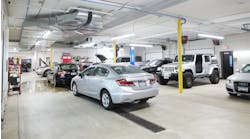Over the past decade, we have trained thousands of service advisors all over North America. Many of you have noticed a major change in customers’ buying habits, and I wanted you to listen to a great suggestion to help you at the counter. This month, our senior team leader to our coaches and instructors, George Zeeks, has several suggestions to help your customers invest in their vehicles.
We all know that the aftermarket auto shop scene has changed yet again. The way you present your recommendations is different now than it was in 2007 or even 2011, and many of the sales staff out there haven’t caught up with the change yet. Top shops have a major reason that they are top shops. They stopped trying to sell their customers and now they have conversations with them. Way too often I see “salespeople” who are great at “selling” the customer. In fact, they are so great at overcoming objections that they shortcut the sales process just to get to the end so they can start doing what they are great at. The issue is that they don’t even realize that they are creating their own problems. If you think you might, just might, have this problem, then you do. Read on and let’s explore the top causes behind the failure to sell.
The Short Sell
I understand what it’s like at the counter when the world is crazy busy. Been there, done that. The temptation to hurry through the presentation can be overwhelming, but the idea that you’re really doing the customers a favor by giving “fast” customer service is the beginning of the end.
Customers deserve a complete explanation of what is going on with their car. The biggest problem comes when you don’t fully explain what you are talking about. Let’s face it, car repair and maintenance isn’t cheap and it’s not going to get any cheaper. Your customers want and deserve a complete, clear description of the things that they need. I cringe when I hear a service advisor recite a laundry list of the things that are needed on a car, with no explanation, and then quote the price. It’s no wonder that people start asking a ton of questions or ask “What can I put off until later?” and the always favorite “I need to think about it.”
Of course they do; you have failed to do the most basic part of your job, which is to tell them what they need in a way they can understand. The “salesperson” now goes into full “sales” mode and begins to launch into a litany of all the reasons why the customer has to have the repairs done right now. This is their idea of overcoming the objection; but they fail to realize that by not doing their job right the first time, they have created the quagmire that they are stuck in.
The Technocrat
In my wayward youth, I once tried to impress a young woman by taking her to a French restaurant. I mean this was a true French — down to the menu in a foreign language — restaurant. With the false confidence that only my four whole semesters of high school French could provide, I felt sure that I could navigate this strange new dining adventure. During our pre-meal small talk, I was paying close attention to the plates arriving at the tables nearby. Now I’ve eaten a lot of strange things in my life, but I’ve never paid these prices for something I couldn’t recognize. I sort of remembered one word that I saw on the menu, poulet, but no amount of head scratching would bring back a clear picture. I did the normal thing and asked the waiter if this was chicken. I must say that he did a fantastic job of making me feel foolish and out of my league when he replied “oui, poulet,” in the worst fake French I’ve ever heard. And he did a great job of looking at me like an unwashed peasant. So I did what I do best. I caused a minor scene by flipping five bucks on the table for the rolls that we had eaten and thanked him for the drinks that never came, and we left.
What does this have to do with an auto shop? Everything. Your customers don’t want a technical answer, they just want to understand. They don’t want or need to know that the fuel injector should be open for 4 to 7 milliseconds and theirs is allowing too much fuel to pass through. Try painting a word picture that reflects things people see every day, and you’ll have better results. How about this: “Have you ever tried to use a bottle of Windex and instead of the fine mist you were looking for, it just kind of ran down your hand? That’s sort of what your fuel injectors are doing.”
Everyone wants to understand what they are buying or they just won’t buy it. If you continue to give technical answers, you end up with a bunch of questions and pretty soon you hear the “I have to think about it” reply. Try as you might, you can’t overcome this objection since you really don’t get what is wrong.
The ‘I’m Here, but Not for You’ Person
Ever buy something at a store and the clerk put your purchase exactly halfway between you and them, so you have to reach for it to pick it up? That employee is more interested in the transaction and collecting the money, than in you as a person. Everyone needs to remember that we are not in the shop for the owner or the technicians or even for our own agenda. We are there for the customer.
I know that it seems like an old cliché, but I see it forgotten all the time in all kinds of businesses. In automotive, we can get so wrapped up in doing the paperwork just right or getting it done really fast that we fool ourselves into thinking we are providing good service. Your customer wants to be appreciated as a person, not seen as just another car to work on. They crave conversation so they can tell you their concerns and feel that you have listened and understood. Ask questions about how they drive and how far, and what they use the car for. This makes it clear that you want to understand them and their needs. Eye contact lets them know that “I see you and I’m here for you.” Staring down at your computer screen while you talk to them can’t ever do that. A smile gives them a feeling of warmth and value that a nod of the head just can’t provide on its own. In this crazy busy world we live in, taking the time to really have that moment together will build clients and fans, not just customers.
Failure or Not: The Choice
It doesn’t feel like failure, since we checked all of our boxes and did the right things in the right order and in the time allotted, but it is. I’ve heard it said that it’s harder now to get people to fix their cars and people aren’t buying like they used to. Well, your customers want and are demanding more from you and your staff. The time has come when a simple laundry list of things that are needed just isn’t cutting it.
It might seem like this is going to take a lot more time, but it really doesn’t take that much. Probably one of the best side effects of having conversations with your customers, instead of a monologue, is that you’re going to enjoy your day and the job a whole lot more. If you would like a quick and simple checklist of the things that will help you communicate better with your customers and have them buy more, simply go to www.ationlinetraining.com/2013-8. Remember, this is a limited time offer.


